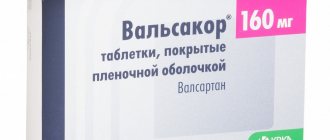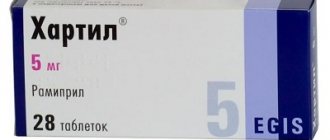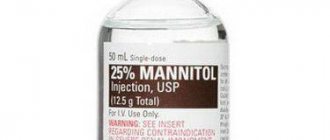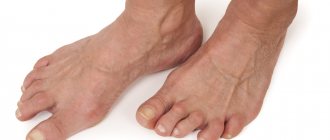Valsacor N80
Active substance:
Valsartan*, Hydrochlorothiazide*
Pharmgroup:
Angiotensin II receptor antagonists (AT1.subtype) in combinations
Average price in pharmacies
| Name | Manufacturer | average price |
| Valsacor 0.08 n30 tablet p/film/casing | KRKA | 336.00 |
| Valsacor 0.08 n90 tablet p/film/shell | KRKA | 745.00 |
| Valsacor 0.16 n30 tablet p/film/casing | KRKA | 372.00 |
| Valsacor 0.16 n90 tablet p/film/sheath | KRKA | 812.00 |
| Valsacor 0.32 n30 tablet p/film/sheath | KRKA | 525.00 |
Analogs for the active substance:Valz N Valsacor N160 Valsacor ND160 Co Diovan | Application area:Vasorenal hypertension Sudden increase in blood pressure Sudden increase in blood pressure Hypertensive circulatory disorder Hypertensive circulatory disorder Hypertensive state Hypertensive state Hypertensive crises Hypertensive crises Hypertension Hypertension Arterial hypertension Arterial hypertension Hypertension is malignant Hypertension is malignant Hypertension, symptomatic Essential hypertension Hypertonic disease Hypertensive crises Hypertensive crises Hypertensive crisis Hypertensive crisis Hypertension Malignant hypertension Malignant hypertension Malignant hypertension Malignant hypertension Isolated systolic hypertension Hypertensive crisis Hypertensive crisis Exacerbation of hypertension Exacerbation of hypertension Primary arterial hypertension Renal hypertension Renovascular arterial hypertension Renovascular hypertension Symptomatic arterial hypertension Transient arterial hypertension Transient arterial hypertension Essential arterial hypertension Essential arterial hypertension Essential hypertension Essential hypertension |
Contraindications
Contraindications to the use of Valsacor are:
- Lactose intolerance, glucose/galactose malabsorption syndrome or galactosemia;
- Age up to 18 years (the safety and effectiveness of its use in children has not been proven);
- Hypersensitivity to the active substance (valsartan) or to other components of the drug.
There are no data on the use of the drug during pregnancy. If pregnancy is established, Valsacor should be stopped immediately. For the fetus, the risk increases in the second and third trimesters.
There are no data on the excretion of valsartan into breast milk. Therefore, taking into account the importance of therapy for the mother, it is necessary to decide whether to interrupt breastfeeding or stop taking the drug.
Valsacor should be taken with caution in the following conditions/diseases:
- Liver failure due to bile duct obstruction;
- Arterial hypotension;
- Stenosis of the artery of a solitary kidney or bilateral stenosis of the renal arteries;
- Renal failure (creatinine clearance <10 ml per minute), incl. patients on hemodialysis;
- Diet with limited sodium intake;
- Hyponatremia;
- Conditions accompanied by a decrease in circulating blood volume, including diarrhea and vomiting.
Instructions:
Clinical and pharmacological group
01.048 (Antihypertensive drug)
Release form, composition and packaging
Pink, oval, biconvex film-coated tablets.
| 1 tab. | |
| valsartan | 80 mg |
| hydrochlorothiazide | 12.5 mg |
Excipients: microcrystalline cellulose, lactose monohydrate, magnesium stearate, croscarmellose sodium, povidone, colloidal anhydrous silicon dioxide.
Film shell composition: hypromellose, titanium dioxide (E171), macrogol 4000, red iron oxide dye (E172), yellow iron oxide dye (E172).
7 pcs. - blisters (4) - cardboard packs. 7 pcs. - blisters (8) - cardboard packs. 7 pcs. - blisters (14) - cardboard packs. 14 pcs. - blisters (2) - cardboard packs. 14 pcs. - blisters (4) - cardboard packs. 14 pcs. - blisters (7) - cardboard packs.
pharmachologic effect
Combined antihypertensive drug.
Valsartan is a selective angiotensin II receptor antagonist of non-protein nature.
It has a selective antagonistic effect on receptors of the AT1 subtype. The consequence of AT1 receptor blockade is an increase in the plasma concentration of angiotensin II, which can stimulate unblocked AT2 receptors, which balances the effects associated with stimulation of AT1 receptors.
Valsartan does not have agonist activity against AT1 receptors. Its affinity for receptors of the AT1 subtype is approximately 20,000 times greater than for receptors of the AT2 subtype. Valsartan does not inhibit ACE, also known as kininase II, which converts angiotensin I to angiotensin II and destroys bradykinin. Due to the lack of influence on ACE, the effects of bradykinin and substance P are not potentiated, therefore, when taking angiotensin II receptor antagonists, the development of a dry cough is unlikely. Valsartan does not interact with or block other hormone receptors or ion channels involved in regulating the function of the cardiovascular system.
In the treatment of arterial hypertension, valsartan reduces blood pressure without affecting heart rate.
After oral administration of a single dose of valsartan, the antihypertensive effect develops within 2 hours, and the maximum reduction in blood pressure is achieved within 4-6 hours.
The antihypertensive effect of valsartan lasts for 24 hours. With repeated prescriptions of valsartan, the maximum reduction in blood pressure, regardless of the dose, is achieved after 2-4 weeks and remains at the achieved level during long-term therapy. The combination with hydrochlorothiazide allows you to achieve a significant additional reduction in blood pressure.
Sudden cessation of valsartan is not accompanied by the “opirouette” syndrome against the background of possible hypokalemia and hypomagnesemia. It is recommended to monitor the content of potassium ions in the blood.
Cardiac glycosides: risk of arrhythmia due to hypokalemia and hypomagnesemia.
Beta-blockers and diazoxide: enhancing the hypoglycemic effect of these drugs.
Uricosuric drugs (probenecid, sulfinpyrazone, allopurinol): it is possible to increase the concentration of uric acid in the blood, as well as an increase in the frequency of hypersensitivity reactions to allopurinol; if necessary, adjust the dose of uricosuric drugs.
Pressor amines (eg, epinephrine, norepinephrine): the effect of pressor amines may be reduced.
Amantadine: The risk of side effects from amantadine increases.
Cytotoxic drugs (for example, cyclophosphamide, methotrexate): the excretion of cytotoxic drugs is reduced and the myelosuppressive effect is potentiated.
Non-depolarizing muscle relaxants (for example, tubocurarine): enhanced effect of muscle relaxants.
Cyclosporine: the risk of hyperuricemia and gout-like complications increases.
Tetracyclines (except doxycycline): risk of increasing serum urea concentrations.
Methyldopa: Cases of hemolytic anemia have been reported.
Lithium: Diuretics reduce the renal clearance of lithium and increase the risk of lithium toxicity; Monitoring lithium levels in the blood is recommended.
NSAIDs (including COX-2 inhibitors, salicylic acid, indoleacetic acid derivatives): the diuretic, natriuretic and hypotensive effect of diuretics may decrease, and acute renal failure may develop.
Concomitant use with calcium supplements and vitamin D can lead to an increase in the content of calcium ions in the blood, which can distort the results of a study of the function of the parathyroid glands.
Use during pregnancy and lactation
The use of angiotensin II receptor antagonists is not recommended in the first trimester of pregnancy. The drug is contraindicated in the II and III trimesters of pregnancy, since use in the II and III trimesters of pregnancy can cause fetotoxic effects (decreased renal function, oligohydramnios, delayed ossification of fetal skull bones) and neonatal toxic effects (renal failure, arterial hypotension, hyperkalemia). If, however, the drug was used in the second and third trimesters of pregnancy, then it is necessary to conduct an ultrasound of the kidneys and bones of the fetal skull.
When planning pregnancy, it is recommended that the patient be transferred to alternative antihypertensive therapy, taking into account the safety profile.
If pregnancy is confirmed, Valsacor® N80 should be discontinued as soon as possible.
There is no data on the excretion of valsartan into breast milk. However, valsartan is known to pass into the milk of lactating rats. Hydrochlorothiazide is excreted in breast milk. Therefore, if therapy with Valsacor® N80 is necessary during lactation, breastfeeding should be discontinued.
Side effects
WHO classification of the incidence of side effects:
| Often | >1/10 |
| often | from > 1/100 to < 1/10 |
| Sometimes | from > 1/1000 to < 1/100 |
| rarely | from >1/10,000 to <1/1000 |
| very rarely | from < 1/10,000, including individual messages. |
Adverse events were generally mild and transient.
From the central nervous system and peripheral nervous system: often - general weakness; sometimes - increased fatigue, asthenia, dizziness, incl. postural, vertigo, insomnia; rarely - headache, depression, paresthesia, neuralgia; very rarely - fainting (when used after myocardial infarction).
From the respiratory system: often - nasopharyngitis; sometimes - upper respiratory tract infections, rhinitis, sinusitis, cough; very rarely - respiratory distress syndrome with pneumonitis and pulmonary edema.
From the cardiovascular system: sometimes - chest pain; often - a pronounced decrease in blood pressure and orthostatic hypotension; very rarely - arrhythmias; potentially - peripheral edema.
From the digestive system: often - diarrhea; sometimes - nausea, dyspepsia, abdominal pain; rarely - gastroenteritis, loss of appetite, constipation, hyperbilirubinemia, increased activity of liver transaminases; very rarely - pancreatitis, intrahepatic cholestasis, jaundice.
From the skin: rarely - skin rash, photosensitivity; very rarely - alopecia.
From the musculoskeletal system: sometimes - pain in the back, limbs, sprains and ruptures of ligaments and muscles or muscle tendons, arthritis, arthralgia; rarely - myalgia, muscle weakness, muscle cramps.
From the genitourinary system: sometimes - decreased libido, impotence (less than 1%), urinary tract infections, viral infections, increased frequency of urination; rarely - hypercreatininemia, increased concentration of serum urea nitrogen; very rarely - renal dysfunction.
From the senses: sometimes - visual impairment; rarely - tinnitus, conjunctivitis.
Allergic reactions: very rarely - angioedema, urticaria, skin rash, itching, hypersensitivity reactions, including serum sickness and necrotizing vasculitis, toxic epidermal necrolysis (Lyell's syndrome), lupus-like reactions, exacerbation of SLE.
From the hematopoietic system: rarely - anemia, incl. hemolytic, leukopenia, agranulocytosis, bone marrow suppression, decreased hemoglobin concentration and hematocrit, neutropenia, thrombocytopenia (sometimes with purpura).
From laboratory parameters: often - hyperkalemia, hypokalemia, hyponatremia, hypomagnesemia, hypercalcemia.
Other: rarely - increased sweating; very rarely - nosebleeds.
Storage conditions and periods
List B. The drug should be stored out of the reach of children, in a dry place, protected from light at a temperature not exceeding 30°C. Shelf life: 2 years.
Indications
- arterial hypertension (in patients for whom combination therapy is indicated).
Contraindications
- severe liver dysfunction;
- biliary cirrhosis of the liver and obstruction of the bile ducts (cholestasis);
- anuria, severe renal dysfunction (creatinine clearance less than 30 ml/min (0.5 ml/sec));
- hemodialysis;
- hypokalemia, hyponatremia, hypercalcemia or hyperuricemia with clinical manifestations refractory to adequate therapy;
- galactose intolerance, lapp lactase deficiency or glucose/galactose malabsorption syndrome;
- age under 18 years (the effectiveness and safety of valsartan in children has not been established);
- pregnancy;
- lactation period;
- hypersensitivity to valsartan, hydrochlorothiazide, sulfonamide derivatives and other components of the drug.
The drug should be used with caution while taking potassium supplements, potassium-sparing diuretics, potassium-containing table salt substitutes and other drugs that can increase the level of potassium in the blood (for example, heparin), chronic heart failure functional class IV according to the NYHA classification, renal failure (CK more than 30 ml/min (0.5 ml/sec)), moderate liver dysfunction, bilateral or unilateral renal artery stenosis or stenosis of the artery of a single kidney, condition after kidney transplantation, conditions accompanied by a decrease in blood volume and/or sodium ions (including diarrhea , vomiting), primary hyperaldosteronism, stenosis of the aortic and mitral valves, hypertrophic obstructive cardiomyopathy (HOCM), systemic lupus erythematosus, hypersensitivity to other angiotensin II receptor antagonists, allergic reactions and bronchial asthma.
special instructions
Patients with severe chronic heart failure in the stage of decompensation or other conditions accompanied by stimulation of the RAAS
The use of Valsacor® N80 in this group of patients is usually accompanied by a more pronounced decrease in blood pressure, however, if the recommendations for dose selection are followed, treatment rarely requires discontinuation due to arterial hypotension. Therapy with Valsacor® N80 should be carried out with caution. Due to suppression of RAAS activity, some patients may develop renal dysfunction. In severe chronic heart failure, oliguria and/or progressive azotemia may develop, up to (in rare cases) acute renal failure and/or death.
In patients with chronic heart failure, regular monitoring of renal function is necessary, while simultaneously prescribing a combination of three classes of drugs - ACE inhibitors, beta-blockers and angiotensin II receptor antagonists (AT1). It may be prescribed in combination with other drugs prescribed after myocardial infarction: thrombolytics, acetylsalicylic acid, beta-blockers and statins.
Patients with hyponatremia and/or reduced blood volume
In patients with severe hyponatremia and/or reduced blood volume, for example, due to taking large doses of diuretics, in rare cases, severe arterial hypotension may develop at the beginning of therapy with Valsacor® N80. Before starting treatment, it is recommended to correct disturbances in water and electrolyte balance, in particular, by reducing the doses of diuretics. If arterial hypotension with clinical manifestations develops, it is necessary to place the patient in a horizontal position with elevated legs, replenish the blood volume and correct disturbances in water and electrolyte balance. Therapy with Valsacor® N80 can be continued only after blood pressure levels have stabilized.
Renal artery stenosis
The safety of using the drug Valsacor® H80 in patients with bilateral or unilateral renal artery stenosis, as well as stenosis of the artery of a single kidney, has not been established (an increase in serum concentrations of urea and creatinine is possible).
Renal dysfunction
In patients with impaired renal function (creatinine clearance more than 30 ml/min (more than 0.5 ml/sec)), no dose changes are required. It is recommended to periodically monitor the content of potassium ions, the concentration of creatinine and uric acid in the blood serum. There is no experience with the use of Valsacor® N80 in patients with recent kidney transplantation.
Liver dysfunction
Patients with impaired liver function are recommended to take no more than 80 mg of valsartan per day. Valsartan is excreted primarily through the intestines with bile. In patients with obstructive biliary tract diseases, a decrease in the clearance of valsartan was observed, so in such cases Valsacor® H80 should be prescribed with caution.
Primary hyperaldosteronism
Valsacor® N80 is not recommended for patients with primary hyperaldosteronism.
SLE
There are reports of exacerbation of SLE with the use of thiazide diuretics.
Other metabolic disorders
Thiazide diuretics may alter glucose tolerance and increase serum concentrations of cholesterol, triglycerides, and uric acid.
Valsacor® H80 contains lactose, so the drug should not be prescribed to patients with hereditary galactose intolerance, lapp lactase deficiency or glucose-galactose malabsorption syndrome.
Impact on the ability to drive vehicles and operate machinery
Patients must be careful when driving vehicles and working with other complex mechanisms that require increased attention, because Dizziness or weakness may develop due to arterial hypotension.
Use for renal impairment
Patients with impaired renal function (creatinine clearance more than 30 ml/min (0.5 ml/sec)) do not require changes in drug doses. The drug should be used with caution in case of renal failure (creatinine clearance <10 ml/min), incl. in patients on hemodialysis with bilateral renal artery stenosis or stenosis of the artery of a single kidney.
Use for liver dysfunction
The maximum recommended daily dose of Valsacor® H80 in patients with mild or moderate liver dysfunction of non-biliary origin is 1 tablet. (80/12.5 mg)/day.
Conditions for dispensing from pharmacies
The drug is available with a prescription.
Release form and composition
Valsacor is produced in the form of film-coated tablets, in blisters of 7 pcs. (40 mg, 80 mg and 160 mg each) and 14 pcs. (80 mg, 160 mg and 320 mg).
1 tablet contains the active substance – valsartan in the amount of:
- 40 mg – brownish-yellow tablets, slightly biconvex, round, scored on one side;
- 80 mg – pink, biconvex, round tablets, scored on one side;
- 160 mg – brownish-yellow tablets, biconvex, oval, scored on one side;
- 320 mg – light brown, biconvex, oval tablets, scored on one side.
Auxiliary components included in the drug: magnesium stearate, lactose monohydrate, microcrystalline cellulose, croscarmellose sodium, povidone, colloidal anhydrous silicon dioxide.
Composition of the tablet shell:
- 40 mg – macrogol 4000, E171 (titanium dioxide), hypromellose, E172 (yellow iron oxide dye);
- 80 mg – macrogol 4000, E171 (titanium dioxide), hypromellose, E172 (iron oxide red dye);
- 160 mg and 320 mg – macrogol 4000, E171 (titanium dioxide), hypromellose, E172 (red iron oxide dye), E172 (yellow iron oxide dye).
Drug interactions
The simultaneous use of Valsacor with angiotensin II receptor antagonists, including valsartan, or ACE inhibitors with aliskiren is contraindicated in patients with diabetes mellitus and impaired renal function (creatinine clearance < 60 ml per minute).
The simultaneous use of Valsacor with lithium preparations is not recommended, since a reversible increase in the concentration of lithium in the blood plasma and the development of intoxication are possible. Combined use with diuretics and lithium preparations may further increase the concentration of lithium and increase the risk of intoxication. If such combined use is necessary, the concentration of lithium in the blood plasma should be carefully monitored.
When used simultaneously with potassium-containing nutritional supplements, potassium preparations, potassium-sparing diuretics, other substances and drugs that can increase the level of potassium in the blood serum (for example, heparin), it is recommended to monitor the level of potassium in the blood plasma.
In some patients, double blockade of the RAAS was accompanied by loss of consciousness, arterial hypotension, impaired renal function (including acute renal failure) and hyperkalemia. Caution must be exercised when using Valsacor simultaneously with angiotensin II receptor antagonists, including valsartan, with drugs that affect the RAAS (aliskiren, ACE inhibitors).
With simultaneous use of Valsacor with non-steroidal anti-inflammatory drugs, including selective COX-2 inhibitors, acetylsalicylic acid in a dose of more than 3 g per day and non-selective non-steroidal anti-inflammatory drugs, the hypotensive effect may be weakened, the risk of renal dysfunction and potassium levels in the blood plasma may increase. At the beginning of treatment, it is recommended to evaluate renal function, as well as correct water and electrolyte imbalances.
Concomitant use of Valsacor with inhibitors of the OATP1B1/OATP1B3 transporter proteins (for example, cyclosporine, rifampicin) and the MRP2 efflux transporter (for example, ritonavir) may lead to an increase in the systemic exposure of valsartan (Cmax and AUC), which should be taken into account at the beginning and at the end of simultaneous therapy .
No clinically significant interaction of Valsacor with the following drugs has been identified: digoxin, warfarin, cimetidine, furosemide, indomethacin, atenolol, hydrochlorothiazide, glibenclamide and amlodipine.
Directions for use and dosage
Valsacor is taken orally, regardless of food intake. Frequency of application – 1-2 times a day.
The recommended dose for arterial hypertension (regardless of the patient's gender, age or race) is 80 mg once a day. The antihypertensive effect develops over 2 weeks, reaching its maximum after 4 weeks. The maximum daily dose is 320 mg. Patients with impaired renal and liver function of non-biliary origin and without cholestasis do not require changes in drug doses. Combination use with other antihypertensive drugs is possible.
In the treatment of chronic heart failure, the recommended initial dose is 40 mg, the frequency of administration is 2 times a day. The dose can be gradually increased to 80 mg, if well tolerated - up to 160 mg (maximum) 2 times a day. In patients simultaneously receiving diuretics, as well as in patients with heart failure, renal function and blood pressure should be constantly monitored. If clinical signs of arterial hypotension develop, the dosage should be reduced.
When using Valsacor after acute myocardial infarction in clinically stable patients, therapy should be started within 12 hours after the onset of the disease. The initial dose is 20 mg 2 times a day (1/2 tablet of 40 mg with a score). The single dose is gradually increased to 40 mg, to 80 mg after 14 days from the start of treatment, and increased to 160 mg after 3 months, without changing the frequency of administration. Achievement of the target dosage depends on the tolerability of the drug during the dose titration period.
If renal failure or symptomatic or arterial hypotension occurs, the dose of the drug should be reduced.
In assessing the condition of patients after myocardial infarction, it is necessary to include monitoring of renal function.
Patients with liver dysfunction of non-biliary origin without cholestasis do not require dose adjustment.
Side effects
When using Valsacor, side effects may develop, manifesting themselves with varying frequencies:
- Respiratory system, chest and mediastinal organs: often - rhinitis, cough, pharyngitis, upper respiratory tract infections, sinusitis;
- Central and peripheral nervous system: often – headache, vertigo, dizziness, incl. postural; infrequently – insomnia; sometimes – fainting (during therapy after myocardial infarction);
- Skin and subcutaneous tissue: rarely - skin rash;
- Genitourinary system: uncommon – decreased libido; very rarely - renal dysfunction;
- Cardiovascular system: often – orthostatic hypotension, marked decrease in blood pressure; sometimes - heart failure (during therapy after a myocardial infarction);
- Muscles, skeleton and connective tissue: often – myalgia, back pain, arthralgia;
- Gastrointestinal tract: often – diarrhea, nausea, abdominal pain;
- Laboratory parameters: often – hyperkalemia; rarely - decreased hematocrit and hemoglobin concentrations, thrombocytopenia, neutropenia, hyperbilirubinemia, hypercreatininemia, increased serum urea nitrogen and liver transaminase activity;
- Allergic manifestations: very rarely - itching, skin rash, angioedema, hypersensitivity reactions, including vasculitis and serum sickness;
- Other: often – a state of general weakness; infrequently – asthenia, edema, increased fatigue.
Clinical data are insufficient, but despite this, the main expected manifestation of an overdose of Valsacor is a pronounced decrease in blood pressure, which can cause shock and/or collapse.
To alleviate the condition, it is recommended to induce vomiting and then rinse the stomach. Hemodialysis is ineffective. If arterial hypotension occurs, intravenous administration of 0.9% sodium chloride solution is indicated.






